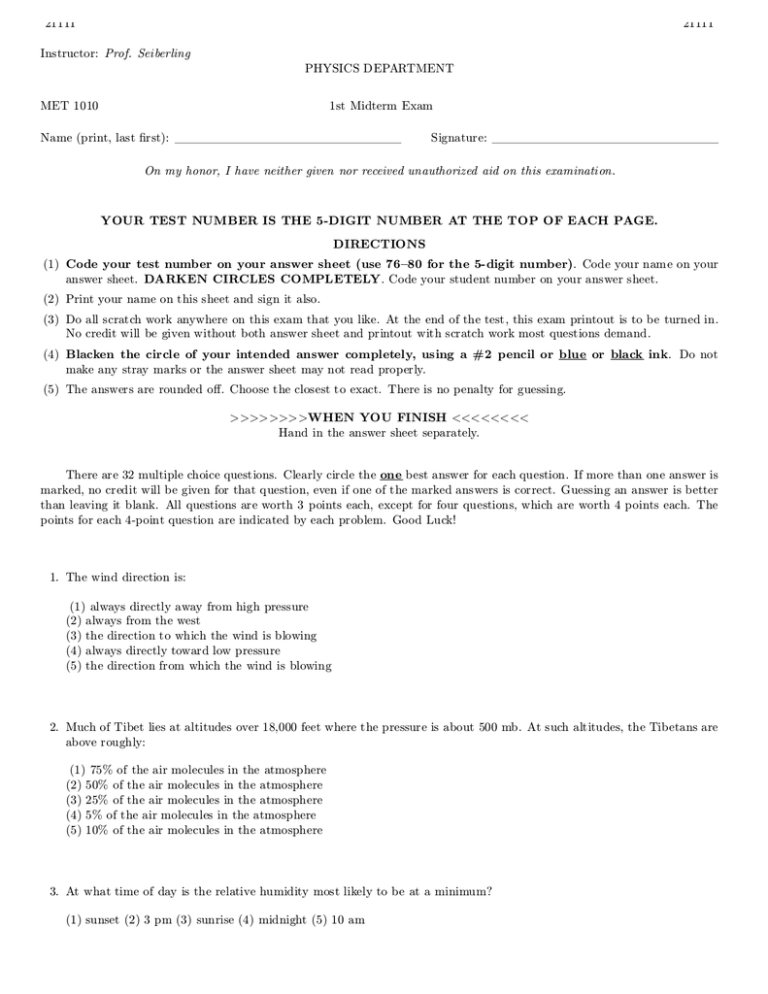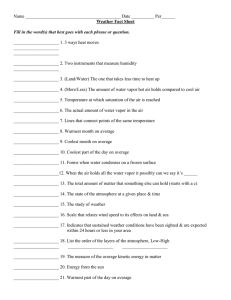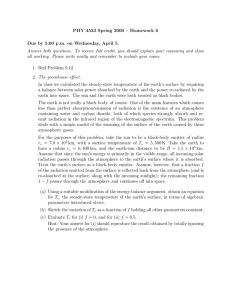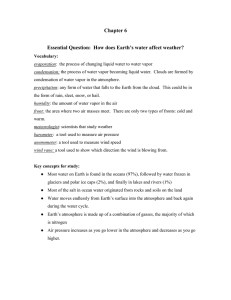21111 Instructor: Prof. Seiberling PHYSICS DEPARTMENT MET 1010
advertisement

21111
21111
Instructor: Prof. Seiberling
PHYSICS DEPARTMENT
MET 1010
1st Midterm Exam
Name (print, last ¯rst):
Signature:
On my honor, I have neither given nor received unauthorized aid on this examination.
YOUR TEST NUMBER IS THE 5-DIGIT NUMBER AT THE TOP OF EACH PAGE.
DIRECTIONS
(1) Code your test number on your answer sheet (use 76{80 for the 5-digit number). Code your name on your
answer sheet. DARKEN CIRCLES COMPLETELY. Code your student number on your answer sheet.
(2) Print your name on this sheet and sign it also.
(3) Do all scratch work anywhere on this exam that you like. At the end of the test, this exam printout is to be turned in.
No credit will be given without both answer sheet and printout with scratch work most questions demand.
(4) Blacken the circle of your intended answer completely, using a #2 pencil or blue or black ink. Do not
make any stray marks or the answer sheet may not read properly.
(5) The answers are rounded o®. Choose the closest to exact. There is no penalty for guessing.
>>>>>>>>WHEN YOU FINISH <<<<<<<<
Hand in the answer sheet separately.
There are 32 multiple choice questions. Clearly circle the one best answer for each question. If more than one answer is
marked, no credit will be given for that question, even if one of the marked answers is correct. Guessing an answer is better
than leaving it blank. All questions are worth 3 points each, except for four questions, which are worth 4 points each. The
points for each 4-point question are indicated by each problem. Good Luck!
1. The wind direction is:
(1) always directly away from high pressure
(2) always from the west
(3) the direction to which the wind is blowing
(4) always directly toward low pressure
(5) the direction from which the wind is blowing
2. Much of Tibet lies at altitudes over 18,000 feet where the pressure is about 500 mb. At such altitudes, the Tibetans are
above roughly:
(1) 75% of the air molecules in the atmosphere
(2) 50% of the air molecules in the atmosphere
(3) 25% of the air molecules in the atmosphere
(4) 5% of the air molecules in the atmosphere
(5) 10% of the air molecules in the atmosphere
3. At what time of day is the relative humidity most likely to be at a minimum?
(1) sunset (2) 3 pm (3) sunrise (4) midnight (5) 10 am
21111
4. Red photons, as compared to green photons:
(1) have longer wavelength
(2) have greater intensity in the suns emission spectrum
(3) have higher energy
(4) are scattered more readily by the atmosphere
(5) are bent by a larger angle in refraction
5. Frost forms when:
(1) the saturation point is above freezing
(2) drops of dew freeze
(3) the temperature falls below freezing without reaching saturation
(4) the saturation point is at or below freezing
(5) fog droplets freeze
6. Radiation fog forms best on a:
(1) cloudy summer night with a slight breeze
(2) clear summer night with a strong breeze
(3) cloudy winter night with a slight breeze
(4) clear winter night with a slight breeze
(5) cloudy winter night with a strong breeze
7. The albedo of the moon is 7%. This means that:
(1) 93% of the sunlight striking the moon is re°ected
(2) 7% of the sunlight striking the moon is absorbed
(3) 7% of the sunlight striking the moon is converted to heat energy
(4) the moon emits only 7% as much energy as it absorbs from the sun
(5) 7% of the sunlight striking the moon is re°ected
8. What is the main reason the sun appears to set later than it actually does?
(1) refraction of sunlight in the atmosphere
(2) re°ection of sunlight in the atmosphere
(3) selective (Rayleigh) scattering of sunlight
(4) dispersion of sunlight in the atmosphere
(5) scattering of sunlight in the atmosphere
9. In the middle latitudes, a rainbow visible in the morning often means:
(1) it will start to rain soon
(2) it has been raining during the night
(3) the dew point is high
(4) the sky will begin to clear soon
(5) you will have good luck that day
21111
21111
21111
10. When viewed from the surface, the smallest individual cloud elements (pu®s) are observed with which cloud?
(1) altocumulus (2) cirrocumulus (3) cumulus (4) stratocumulus (5) cumulonimbus
11. A special jet takes an open °ask of water up to an elevation of 9 miles above sea level, where the air pressure is about
100 mb. At what temperature will the water boil at this elevation? (Use the table provided.)
(1) 100 ± F (2) 115 ± F (3) 92 ± F (4) 78± F (5) 212 ± F
12. A halo around the moon means that:
(1) cirrostratus clouds are present
(2) the clouds are composed of water droplets
(3) the clouds overhead are low clouds
(4) a religious holiday is near
(5) rain is falling from the clouds overhead
13. (4 pts) Describe the path of the sun at 13.5 ± N latitude on June 21.
(1) the sun rises in the SE, then peaks at 23.5 ± N of straight up at noon, then sets in the SW
(2) the sun rises in the SE, then peaks at 10 ± S of straight up at noon, then sets in the SW
(3) the sun rises in the NE, then peaks at 10± N of straight up at noon, then sets in the NW
(4) the sun rises in the NE, then peaks at 10± S of straight up at noon, then sets in the NW
(5) the sun rises in the SE, then peaks at 10 ± N of straight up at noon, then sets in the SW
14. The fog that forms along the Paci¯c coastline of North America is mainly this type:
(1) advection fog (2) upslope fog (3) steam fog (4) frontal fog (5) radiation fog
15. During the last 100 years, CO 2 in the atmosphere has:
(1) been decreasing in concentration
(2) been increasing in concentration
(3) become concentrated at the equator
(4) disappeared entirely
(5) remained at about the same concentration from year to year
16. When the air is saturated, which of the following statements is NOT correct?
(1) the air temperature equals the dew point temperature
(2) the rate of evaporation equals the rate of condensation
(3) the air temperature equals the wet-bulb temperature
(4) an increase in temperature will cause condensation to occur
(5) the relative humidity is 100%
21111
21111
17. If water vapor comprises 3.5% of an air parcel whose total pressure is 1000 mb, the water vapor pressure would be:
(1) 1000 mb (2) 35 mb (3) 1035 mb (4) 350 mb (5) 965 mb
18. (4 pts) A parcel of air has a temperature of 80 ± F and a relative humidity of 50%. What is the dew point of this parcel?
(Use the table provided.)
(1) about 70± F (2) about 80± F (3) about 90± F (4) about 60± F (5) about 32 ± F
19. In the northern hemisphere in January, the oceans are generally
than land.
than land and in July the oceans are generally
(1) co oler, cooler
(2) land and oceans should be the same temperature
(3) cooler, warmer
(4) warmer, warmer
(5) warmer, cooler
20. Which of the following is the best indicator of the actual amount of water vapor in the air?
(1) air temperature (2) wet-bulb depression (3) dew point temperature (4) saturation vapor pressure (5) relative humidity
21. Why is the \green °ash" not the \violet °ash"?
(1) green light bends more than violet light due to refraction in the atmosphere
(2) green light is emitted by the sun at its periphery
(3) green and violet light bend the same due to refraction, but violet light is absorbed in the atmosphere
(4) violet light is not as abundant as green light in the sun's emission spectrum
(5) violet light is too low in energy to pass through the atmosphere
22. Suppose last night was clear and calm. Tonight low clouds will be present. From this you would conclude that tonight's
temperature will be (assuming the daytime temperature is the same):
(1) the same as last night (2) below freezing (3) above freezing (4) warmer than last night (5) cooler than last night
23. You wish to install solar hot water collectors on the roof of a house you are building so that you get the most heating
during the cold months. If you are building the house at latitude 15 ± S, what pitch should your roof have (pitch is the
angle down from horizontal) and what direction should the roof with the collector face?
(1) about 15 ± , toward the north
(2) about 30± , toward the north
(3) about 30± , toward the south
(4) about 15± , toward the south
(5) about 23± , toward the south
21111
21111
24. The horizontal transport of any atmospheric property by the wind is called:
(1) re°ection (2) conduction (3) advection (4) radiation (5) latent heat
25. Most of the radiation emitted by a human body is in the form of:
(1) visible radiation, but is too weak to be visible
(2) infrared radiation and is invisible to the human eye
(3) ultraviolet radiation and is invisible to the human eye
(4) visible radiation, visible only in a completely dark room
(5) humans do not emit radiation
26. Which of the following gases are mainly responsible for the earth's atmospheric greenhouse e®ect?
(1) oxygen and nitrogen
(2) water vapor and carbon dioxide
(3) nitrogen and carbon dioxide
(4) chloro°uorocarbons and oxygen
(5) ozone and oxygen
27. The ozone hole is found in this atmospheric layer:
(1) exosphere (2) mesosphere (3) stratosphere (4) thermosphere (5) troposphere
28. When water changes from a vapor (gas) to a liquid, we call this process
, and heat energy is
.
(1) condensation, absorbed from the environment
(2) condensation, released to the environment
(3) sublimation, absorbed from the environment
(4) deposition, released to the environment
(5) evaporation, released to the environment
29. The day is Dec. 21 and you are at the equator. In what direction do you look to observe sunrise?
(1) E (2) NE (3) SW (4) NW (5) SE
30. (4 pts) If a pilot balloon rises at a rate of 200 m per minute, and if it disappears into a cumulus cloud base in 10 minutes,
what is the ceiling of the cloud layer?
(1) 1000 m (2) 2000 m (3) 3000 m (4) 500 m (5) 200 m
21111
21111
31. Why is the sun red at sunset?
(1) dust in the atmosphere is generally red (clay), which re°ects red light
(2) because blue light is preferentially scattered by the atmosphere
(3) the oceans absorb most of the blue light at the small angle during sunset
(4) because red light is preferentially scattered by the atmosphere
(5) the dimness through the thick atmosphere makes the sun appear red
32. (4 pts) How many cooling degree-days would there be for a day with a maximum temperature of 95 ± F and a minimum
temperature of 65 ± F ? (Assume a base temperature of 65 ± F)
(1) 25 (2) 0 (3) 30 (4) 15 (5) 10
21111
21111







